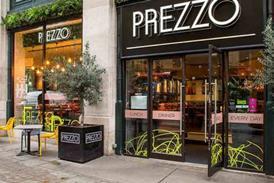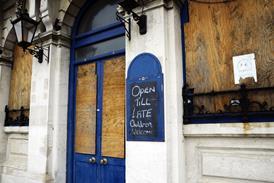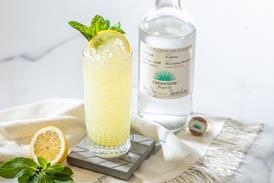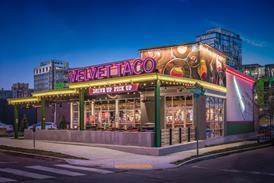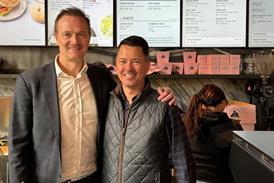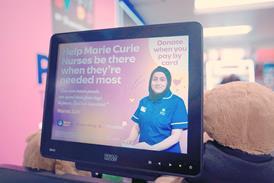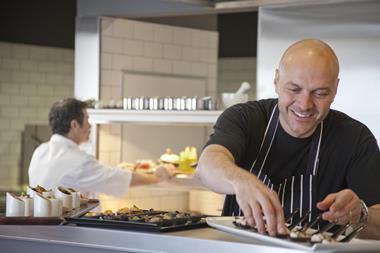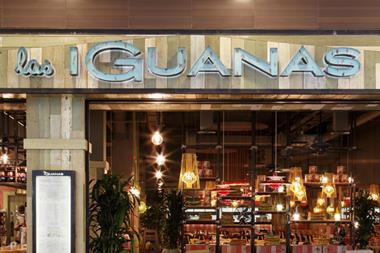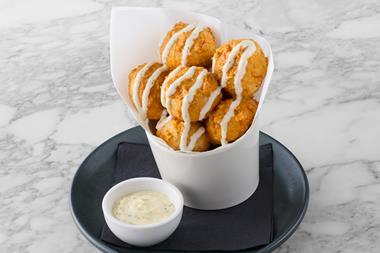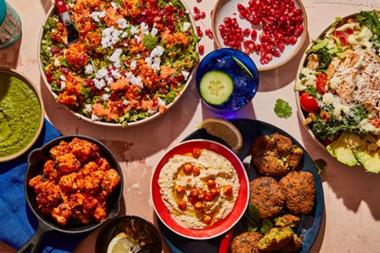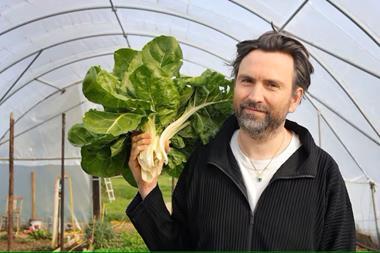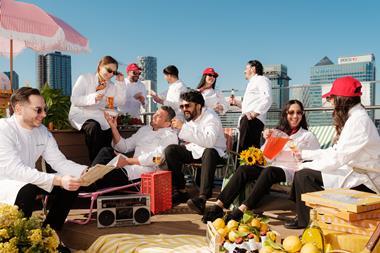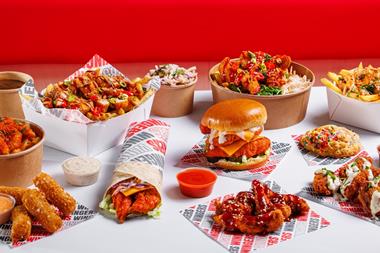Virtual restaurants might sound like a computergenerated fabrication – but the food they delivery is very much a physical reality, and it’s growing. As the major delivery companies start to push into restaurant brands, Finn Scott-Delany examines the lie of the land.
The term ‘virtual restaurants’ is so new, there is little common ground on what they should be called. Variously referred to as ghost restaurants, digital or delivery-only kitchens, the concept is the same – restaurant brands without a store front, operating in a particular location from a ‘dark kitchen’ for the sole purpose of home delivery.
As with many trends in food and tech, the US is a few years ahead, with early examples such as David Chang’s Ando, and plantbased Green Tiffin operating as long as two years ago, the former since acquired by Uber.
But the UK is getting in on the act, with the two key players, Deliveroo and Uber Eats announcing plans to significantly expand the number of such brands on their platform, and Just Eat working on its own initiative with kitchen operator Vessel.
For the delivery companies, the development gives them more ‘content’ for consumers to choose from on their platforms, and they are able to use consumer data to identify cuisine gaps in particular geographies, and advise operator partners on how to refine and develop new brands.
Suitable for all sizes of operator
For operators, the argued benefits are similar to those for wider home delivery – incremental revenue growth opportunities.
Bigger brands are able to utilise existing kitchen resources to quickly test new, delivery-optimised products; while smaller operators can avoid eye-watering start-up costs and city-centre business rates with off-pitch delivery only kitchens.
Operator-wise, a clear pioneer of virtual brands in the UK is Motu, the Indian kitchen from JKS Restaurants that operates with Deliveroo Editions.
And Motu may well not have been able to launch without the Deliveroo platform, which is going one step further by taking ownership of food production infrastructure through its Editions initiative, the testing lab for scores of new virtual brands. The tech company already has 300 virtual restaurants live on its platform in the UK – and told MCA of plans to open a further 100 this month.
The company has set aside a £5m innovation fund to develop new concepts with partners, led by the team from Maple, the US start-up that was acquired last year. Deliveroo’s dominance in the space has led to fears among operators that it is looking to replace them with its own brands – though the company insists these are created in collaboration with partners.
Practically speaking, these partnerships means identifying cuisine gaps in a market, advising on menus and pricing, and helping adapt Editions kitchens to accommodate new brands.
For consumers, this means new cuisines in previously unreached areas. With poke a hot cuisine trend, operators already experienced in working with raw fish are getting in on the act.
Yoobi is behind Lolo Poke in Whitechapel Editions, and plans to take both brands to Paris as virtual restaurants via Deliveroo. Moshimo in Brighton has launched a poke brand that it hopes to launch outside of its home city. And Chilli Banana in Manchester has three virtual brands – Poke Blu, Go Get Sushi and Pho and Roll – which operate out of Editions kitchens.
High-profile chefs want in
The lack of physical restaurant can mean rapid changes to brands and concepts that would traditionally have been impossible. Lievita, the Milan-founded pizza concept, which made its debut as a virtual restaurant via Deliveroo late last year, has launched a spin-off brand, South Saints Pizza, to appeal to UK audience. Proove, the Neapolitan pizza concept, is diversifying into New York-style pizza with Pizza Stars.
And it is even providing opportunities for high-profile chefs; Simon Rimmer recently announcing rotisserie concept Headless Chicken for Salford Editions.
Meg Fairfield, Deliveroo director of partner services, says the company was using “insight, knowledge and expertise” to help restaurants build new brands.
She says: “We are market leaders in working step by step to design, build and test new concepts that brings customers amazing meals and restaurants new revenue streams.
“For us, this is about delivering highquality concepts that are built to last and that’s why we support restaurants with a dedicated team to delivery this new and innovative concept.”
Uber Eats shuns real estate
Rival Uber Eats is also busy in this area, with plans to have 400 brands on its platform by the end of the year. While unlike Deliveroo, it says it has no stated interest in the real estate side, Uber Eats tells MCA it is working with “hundreds of restaurants” across the UK to help them identify selection gaps in their area that present an opportunity to launch a virtual restaurant from the same kitchen.
Examples include Desserts and Milkshakes, a dessert brand from Balti Cottage in Dagenham; Mr Falafel, a Lebanese concept from Café Noir in Camberwell; and Poke Zone, a new concept from Sushi Circle in Bethnal Green.
Meanwhile Just Eat has its own ‘digital pop-ups’ scheme, live in Manchester, Leeds and London, with kitchen operators Vessel, which is licensed to produce food on behalf of brands such as Bird, Buns & Buns and Dirty Bones.
A taste of what’s to come
Vessel leverages the real estate of associate business Park Jockey, which includes Dirty Bones’s Dipak Panchal as a director, to open delivery-only kitchens in car parks and unused industrial space, and is operational in about seven sites across the UK, with plans for 50. “The pop-ups are a fantastic way for us to give customers a taste of great new flavours that they wouldn’t have otherwise been able to enjoy and helping small innovative businesses expand to new areas – enabling them to test the water without the risk associated with setting up a bricks and mortar shop,” a Just Eat spokesperson says.
Just Eat tells MCA it was sharing information on customers’ food preferences in specific locations to allow restaurants to tailor their menus, and providing data on order patterns to give insight to restaurants when setting their delivery ranges or when considering where to open new outlets.
There are also companies that create restaurant brands for delivery-only, with Taster, a French start-up run by a former Deliveroo executive, securing £3m in investment, with expansion into London on the cards. Brand-wise, operators such as Barburrito are working across multiple platforms, testing the water with diversified brands such as Mayella Mexican Kitchen.
Big-name brands’ spin-offs
Founder Morgan Davies tells MCA it was one of a number of options being explored to maximise delivery potential, and give consumers more options.
Davies says: “Mayella is an interesting test bed. It’s not a finished product, but part of our NPD cycle. We have also got some other ideas going on in the background. It also gives consumers variety in terms of product and price point, and gives us the chance to trial alternative dishes to see what gets traction. “It’s one of a number of options we’re exploring, but it’s very early days.”
Major operators are also testing new concepts, with The Restaurant Group’s Chiquito launching Kick-Ass Burrito and Frankie & Benny’s home to Burger Burger. Casual Dining Group’s Las Iguanas is another bigger name that has launched a spin-off brand, alongside CDG stablemate Café Rouge’s Stack & Grill. Blazing Bird started life as an item on Las Iguanas’s menu – a grilled half-chicken with a choice of sauce – which was trademarked as long as five years ago.
New brand, no extra rent
Las Iguanas managing director Mos Shamel says the brand took just 10 days to launch on the platform after a decision had been made to spin it off as a white label brand.
“It’s pretty dynamic in terms of being able to move quickly with something”, he says. “Usually when you create a brand, it takes months or even years to get it off the ground. This is just a new way of testing whether a new brand can work, without the roll-out costs. It has allowed us to have a new brand without paying any extra rent. We have the resources, the skilled chefs. It means more cash coming into sites, more labour. It’s an easy sell, because the workforce feel you’re helping to grow the business. It’s become a popular white label and allows us to launch the equivalent of 53 food trucks, without the expenditure.”
There is even the chance Blazing Bird could be spun out into its own bricks and mortar restaurant. Shamel adds: “We know this works across the country and we have all these areas we operate in. It would be great to say one day, let’s open a 3,000-4,000sq ft business and make it into a proper restaurant brand.”
Element of trust
But when ushering in a new wave of brands that can disappear as quickly as they appear, what are the implications for brand loyalty on a high street that is being reshaped before our eyes? For Ted Schama, managing partner at Shelley Sandzer, who first wrote about the phenomenon for MCA 18 months ago, there is a huge question mark over how consumers will take to new brands they have no previous physical relationship with.
“If you’re visiting these websites, and you’re hungry, the consumer is generally drawn to brands they know and trust, because they’ve seen them physically, and have a relationship with them physically.
“Even now, when you order say PizzaExpress, you might want to know what branch it’s coming from.
“There’s an element of trust that comes from the strength of brands.” Schama believes virtual restaurants have a better chance of success when they use their mother brand to leverage recognition, such as Tortilla’s move into delivery-only kitchens.
“That makes sense and will gain traction, because people know and trust the brand – it’s also very transportable. “It’s a workable route for expansion, which mitigates their property costs.”
Brand promiscuity
Despite it being a hot topic of conversation in the industry, Schama believes there is a way to go before such brands gain consumer recognition: “Its fresh news. It hasn’t gained particular traction. These brands don’t roll off the tip of your tongue.” Indeed, the coming and going of many brands suggests a space very much in its formative, experimental stages.



